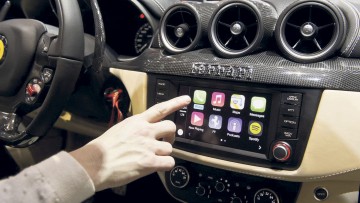It’s a sign of the times that the biggest news story at this year’s Consumer Electronics Show in Las Vegas could not be measured in terms of pixels, megabits or watts, but kilometres per hour.
Until now the car industry has been something of a bit player at this global tech event, yet when in January Daimler AG chief executive Dieter Zetsche unveiled the Mercedes-Benz F 015 Luxury in Motion (pictured above), it stole the show. Why? Simply put, it embodies everything that’s exciting about the nascent connected-car market.
With its fluid metal profile, living-room style seating configuration and laser-projection system, the F 015 undoubtedly charms from a design perspective, but its real potential lies in its engineering. This is a fully autonomous car powered by two rear-mounted electric motors with a roof-mounted GPS fin ensuring it safely arrives at its destination. What’s more, it actually works, hence Dr Zetsche’s insistence on describing this innovative four-seater as a “research” model rather than mere “concept”.
75 per cent of cars on the roads in the world will be autonomous by 2040
The adoption of autonomous automobiles could feasibly mark the biggest evolution in personal transport since the transition from horse-drawn carriage to car. Yet this so-called revolution is unlikely to see the light of day until it has both satisfied the scrutiny of lengthy public safety legislation and convinced consumers to cede control of their steering wheels.
While the Institute of Electrical and Electronics Engineers predict that 75 per cent of cars on the roads in the world will be autonomous by 2040, a recent study by KPMG provides a more sober forecast. In its 2015 Global Automotive Executive Survey, a poll of 200 senior executives from the world’s leading automotive companies, only 3 per cent of respondents viewed self-driving cars as an “extremely important” market trend, while in the North America market, 60 per cent of those interviewed believed the breakthrough for autonomous driving won’t arrive for at least 21 years.
Nissan may already have committed to installing fully driverless systems in its cars by 2020, but for the time being a form of semi-autonomous functionality is fast becoming the norm, in which drivers relinquish a degree of control over acceleration, braking and steering without absolving themselves from responsibility.
Take Mercedes-Benz’s 2014 S-Class, for instance, which features Stop-and-Go Pilot – an optional package providing full-speed adaptive cruise control and active lane-keeping assistance; or BMW and Volvo, both of whom have integrated Traffic Jam Assist systems to their fleets to relieve safely the tedium of nose-to-tail traffic.
In March, Tesla chief executive Elon Musk announced a new “autopilot” feature for the manufacturer’s Model S cars, to be available by the summer via a software update, which will allow the car to assume complete control – albeit, for now, only on motorways.
In-car navigation systems have long been the natural precursor of the connected car movement, providing real-time geolocation, turn-by-turn maps and traffic updates via often irksomely small displays – or worse still, robotically dictated routes – but this well-established sector is also undergoing something of a renaissance.
At the end of 2014, Jaguar Land Rover unveiled its Urban Windscreen technology, a heads-up concept comprising a virtual “ghost” car that leads the way while simultaneously displaying contextual data such as petrol prices at the nearest garage. It also promises to eradicate blind-spots by integrating video displays into the windscreen pillars that literally fill in the gaps for a safer, wraparound field of view, although there’s no timeline for its implementation.

Nonetheless practicable heads-up displays are already in circulation. Pioneer’s NavGate head-up display (HUD) is a transparent screen that clips on to the car’s sun visor, projecting information directly on to the glass using navigational apps such as CoPilot Live. In a similar vein is Navdy, a plug-and-play HUD, currently available for pre-order, which can be safely operated at the wheel using basic, gesture-based commands.
Increased interaction with smartphones is also driving the connected car revolution. Last September, a brand partnership between Ferrari and Apple ensured the Monza manufacturer’s four-door FF became the first vehicle to be pre-fitted with Apple CarPlay, the vaunted infotainment system designed to replicate iOS apps via an enlarged dashboard touchscreen.
CarPlay’s unique selling point is its eyes-free interface, which utilises its proprietary Siri to provide voice-activated telephony, text messaging, music playback and way-finding; an after-market partnership with Pioneer and Alpine Electronics means you won’t have to buy a new car to benefit from the service. Google’s rival Android Auto platform has established the Open Automotive Alliance, an umbrella group of 28 manufacturers, from Alfa Romeo to Maserati, promising an open, voice-activated eco-system for driver-centric Android apps.

Apple CarPlay in Ferrari FF
Bleeding-edge connectivity needn’t be an either-or choice, however. Jaguar has already developed its own connected app interface, InControl, that’s intentionally compatible with both iPhones and Android handsets, and highlights location-specific events and services alongside calendar reminders and playlists.
BMW’s iRemote app for its i3 and i8 models shows detailed real-time data on the electric car’s location, battery status and nearest charging station, as well as allowing you to remotely activate the air-con ahead of a journey.
Tesla, meanwhile, has seen fit to replace the entire central console of its Model S cars with a 17-inch tablet that manages everything from climate control to cabin lighting. It also houses a 3G-enabled web browser for internet on the go. The California company has guaranteed free data connectivity until January 2018, which should be more than enough to keep you occupied while your car patiently navigates the M4 corridor.


